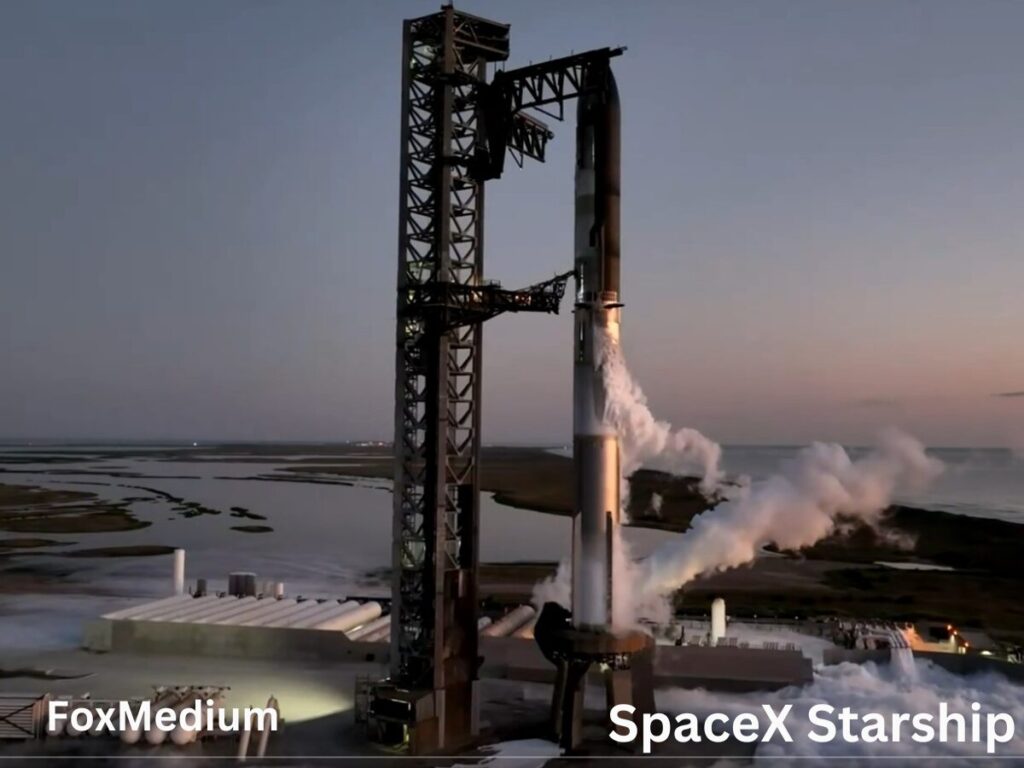
- SpaceX continues to redefine the future of space travel with its groundbreaking innovations. On 13th October 2024, SpaceX launched its Starship rocket for the fifth time, marking another significant step towards reusable rockets and more efficient space missions. With the focus on perfecting a novel booster recovery system, this launch not only tested the rocket’s capabilities but also explored how far SpaceX’s vision can take humanity.
SpaceX StarshipStarship’s Fifth Flight: Key Highlights
The recent SpaceX Starship launch drew immense attention from space enthusiasts and industry experts alike. The fifth flight of Starship was designed to push boundaries, aiming to make space travel more sustainable and cost-effective.
Elon Musk, CEO of SpaceX, expressed his excitement about this particular flight, saying, “Starship’s potential is limitless. We’re not just talking about Mars or the Moon anymore; we’re looking at a new era of space exploration that’s far more accessible than ever before.”
This fifth flight is another crucial step in testing and improving the Super Heavy booster — an essential part of the Starship system. The booster is responsible for providing the initial thrust needed to propel Starship into space, and the recent test marks an exciting shift in how SpaceX plans to recover these boosters for future missions.
The Novel Booster Catch System: A Game Changer
Perhaps the most intriguing aspect of this flight is the novel booster catch system SpaceX is testing. Reusable rockets have been a goal for many space agencies, but SpaceX is moving forward rapidly with a more ambitious approach. Traditionally, boosters are either discarded or land on drone ships in the ocean, requiring extensive refurbishment before reuse.
However, this new system aims to catch the Super Heavy booster mid-air, using an arm-like structure mounted on the launch tower. This method could drastically reduce wear and tear on the boosters, allowing them to be relaunched more quickly and efficiently. By eliminating the need for drone ship landings, the recovery process becomes faster and more streamlined.
SpaceX has already demonstrated its commitment to reusable rockets, and this innovative booster catch could significantly enhance the sustainability of space missions. Gwynne Shotwell, President and COO of SpaceX, commented, “If we can perfect this system, it will revolutionise how we think about reusability in space travel. The implications are enormous for future missions to the Moon, Mars, and beyond.”
The Technology Behind Starship
SpaceX’s Starship is a fully reusable spacecraft designed to carry both crew and cargo to a variety of destinations, including Earth’s orbit, the Moon, Mars, and possibly beyond. It is built to be the most powerful launch vehicle ever developed, with the capacity to carry more than 100 metric tonnes of cargo.
The Raptor engines powering Starship use liquid methane and liquid oxygen (methalox), making it different from traditional rocket engines that rely on kerosene. Methane as a fuel source offers a cleaner burn and makes refueling on distant planets like Mars more feasible, where methane could be produced from local resources.
Moreover, the Starship’s design includes cutting-edge materials such as stainless steel, which is both durable and cost-effective. This helps the rocket withstand the high temperatures encountered during re-entry, increasing the spacecraft’s longevity and reducing the need for extensive repairs.
The advancements in booster recovery are complemented by innovations in heat shields, which protect the rocket during re-entry. SpaceX is constantly improving the heat shield tiles that cover the Starship to ensure safe returns, particularly when the rocket is used for multiple missions.
Real-World Applications of SpaceX’s Technology
While the excitement around space exploration often focuses on distant planets, the technology behind SpaceX’s Starship has real-world implications that can benefit industries here on Earth.
Transportation and Logistics
Reusable rockets could transform the way we think about global transportation. Starship’s ability to carry heavy payloads opens new possibilities for high-speed cargo delivery, especially to remote or hard-to-reach locations. This could drastically reduce the time it takes to ship goods, with the potential for global deliveries in under an hour.
Satellite Deployment
With its heavy-lift capabilities, Starship will also be crucial for launching large constellations of satellites. These satellites will enhance global internet coverage, facilitate climate monitoring, and even support disaster management. SpaceX has already made strides with its Starlink project, and Starship will only accelerate these efforts.
Deep Space Exploration
Of course, the most exciting application of Starship’s technology is its potential for deep space exploration. As SpaceX refines its reusable rocket system, the dream of colonising Mars or building lunar bases becomes more tangible. The cost savings from reusable rockets will make space travel more accessible to both governments and private companies, potentially sparking a new space race.
Conclusion: What’s Next for SpaceX and Starship?
The fifth flight of SpaceX’s Starship marks a significant leap forward in humanity’s journey toward deeper space exploration. With the introduction of a novel booster catch system, SpaceX is pushing the boundaries of what’s possible in reusable rocket technology. This isn’t just about reducing costs; it’s about opening new frontiers and making space travel as routine as air travel.
As SpaceX continues its tests and fine-tuning, the possibilities for Starship seem endless. Whether it’s delivering goods across the globe or launching humans to Mars, the technology developed in this program is laying the groundwork for the future.
So, what do you think? Could SpaceX’s Starship become the standard for space exploration? Leave a comment below and share your thoughts on the future of space travel!

